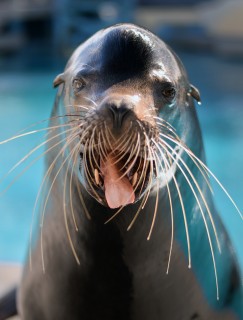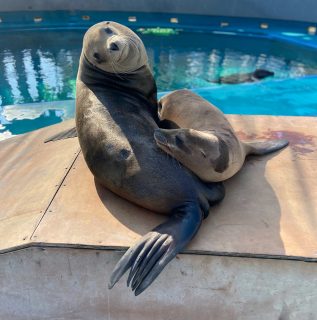
July 19, 2023
Osborn’s Biopsy
- as seen by -
 Stephanie Graehling
Stephanie Graehling
Have you ever wondered what happens to zoological animals if they acquire a cut or lesion? Just like humans, all animals are prone to various injuries and illnesses throughout their lives. Animals require many types of care and training that prepare them to calmly participate in their own health care.
A few months ago, 23-year-old, 550-pound California sea lion (Zalophus californianus) Osborn that lives at the Wildlife Conservation Society’s New York Aquarium participated in a voluntary biopsy of a lesion he had on his upper back. For several weeks, staff had noticed an area of his skin, where the fur had not been growing, looked irritated. Upon examination by our veterinary staff, several topical treatments were applied to try to help the area heal. After a few months, the veterinary team decided to get a sample of the area to see what was going on under a microscope.
I started training sessions with Osborn to familiarize him with each step of the biopsy process. Fortunately, Osborn was already a pro at many of the husbandry and medical behaviors we train with our animals for this very reason. Very reliably, he voluntarily presents different body parts for examination, and has routinely participated in radiographs, vaccinations, ultrasounds, eye drops, and even blood draws.
For the procedure, Osborn would be injected with lidocaine, a local anesthetic, around the wound site. To prepare for this, I utilized the same training that Osborn was familiar with for receiving a vaccine but did it around the wound. Osborn never showed signs of discomfort for any of his training. I also prepared him for pressure on the wound. I utilized different objects to press down on that part of his body to try to replicate the pressure of the biopsy tool. After several weeks of training, Osborn was ready. The entire process went very smoothly and was a success.
First, Osborn was asked to lay out on his belly so that we had clear access to the wound site on his back. The veterinarian injected lidocaine in several locations around the wound. We allowed 10 minutes for the lidocaine to take effect to minimize any pain associated with the biopsy. Next, the veterinary staff cleaned the wound and area around it thoroughly while Osborn continued to voluntarily lay comfortably and still. After cleaning, the veterinarian then took the biopsy tool, which looks much like a pen, and pushed it into the center of the wound. This created a circular cut. The biopsy piece was then lifted with tweezers and a final snip was made with scissors. The veterinarian took a swab of the exposed area. Lastly, the veterinarian applied gel foam to control bleeding. Osborn was a rock star throughout the entire process.
It took a few weeks for the veterinary team to receive results from the biopsy and ironically, the wound started to slowly heal. The results from the biopsy determined that it was recurring trauma in the same spot. Whatever caused the wound was never determined. It continued to heal until his skin was of normal color, and he began his seasonal molt (losing fur and growing new fur). New fur began to grow in the wound location.
Osborn is a great example of the training that is possible with animals. It is truly limitless. Knowing all these medical behaviors is key to Osborn living a healthy life. He is such a gentle soul and trusting of his trainers. He teaches us so much about patience. We feel that he teaches us more than we teach him. Working with him every day is truly an honor.
EDITOR’S NOTE: This week is National Zookeeper Week, a time to recognize our keepers’ hard work, conservation efforts, and passion in caring for animals. Check out our WCS keepers in this video produced by the WCS video team.



Leave a Comment